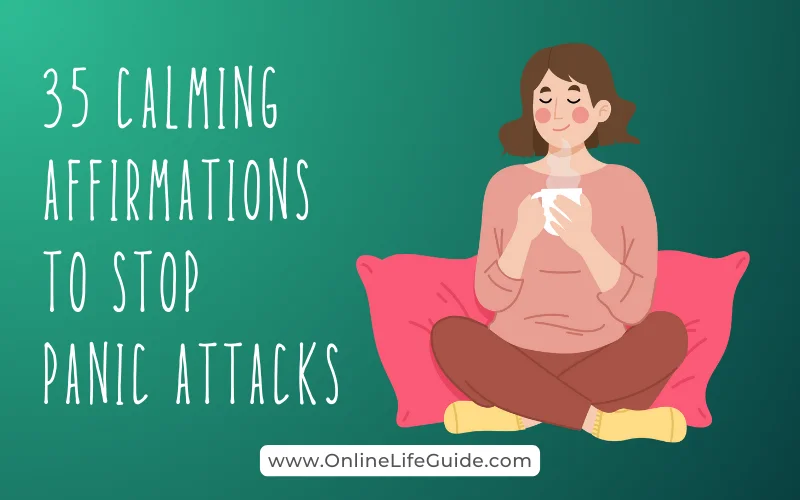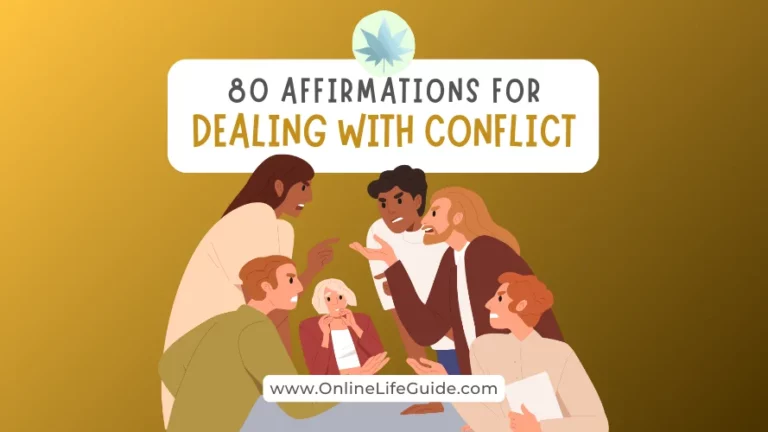35 Affirmations to Stop Panic Attacks

The following Affirmations for Stopping Panic Attacks are designed specifically to deal with the triggers that lead to a panic attack and the symptoms that occur during it.
These affirmations will help you calm your mind and body before or during panic attacks and put you in a proactive state keeping you from feeling stuck or overwhelmed.
For your ease, I’ve divided the affirmations into several sections. Here’s an overview. Feel free to jump between sections:
- Affirmations for Dealing with a Panic Attack
- Calming the Physical Symptoms of a Panic Attack
- Dealing with Uncertainty and Anticipation
- Dealing with the Fear of Losing Control
- Calming Down Your Mind
- How to Use These Affirmations to Stop Panic Attacks
- Additional Resources
Dealing with Panic Attacks

When a panic attack occurs or is about to happen, one of the crucial symptoms to pay attention to is the shallowness of breathing and it can go as far as shortness of breath.
The feeling of losing control is natural. To take back control of your mind and body, start by focusing solely on your breath for a couple of minutes. Take really deep breaths.
You’ll notice that your chest feels tight and you have to force a deep breath in. That is the key. No matter how much your mind wants to go back to focusing on the problem and no matter how much your body resists expansion of your chest, you just focus on deepening your breath.
Inhale slowly, exhale gently. Picture each breath as a wave of calm washing over you, soothing the physical discomfort. Your body is resilient, and it’s okay to let go of tension.
Recognize that you have the power to navigate through these tough moments. When panic knocks, take a deep breath and remind yourself that it’s temporary. You’re stronger than you think.
Life is full of twists and turns, but you’re capable of handling whatever comes your way. Trust in your natural adaptability. We, humans, can adapt to any circumstance and figure things out eventually, remember that.
Don’t forget to ask for help when needed. You don’t always have to face life on your own. Reach out to someone, parents, spouse, friends, relatives, mental health professional, or a religious figure.
35 Calming Affirmations to Stop Panic Attacks

Affirmations for Dealing with a Panic Attack
1. I am in control of my breath, calming my mind and body during moments of panic.
2. Panic may knock, but I choose not to let it in. I am resilient and can overcome it.
3. I trust in my ability to navigate through tough situations and emerge stronger on the other side.
4. Each breath I take fills me with calm, dispelling panic and restoring peace within.
5. I release the grip of fear, knowing that I am capable of managing any panic that arises.
6. My inner strength is greater than any panic attack. I face them with courage and grace.
7. Difficult situations are temporary. My strength and resilience are everlasting.
Calming the Physical Symptoms of a Panic Attack
1. I relax my body, letting go of tension and allowing calmness to take over.
2. My body is a vessel of peace, and I release any physical symptoms of panic with ease.
3. I am grounded, and as I exhale, tension dissipates, leaving only serenity within me.
4. I nurture my body with soothing breaths, letting go of any physical unease that may arise.
5. Each breath I take is a step towards deep tranquility that relaxes my mind and body fully.
6. My body is resilient, and I choose to cultivate a state of calm in the face of any discomfort.
7. Physical sensations may come, but they also go away eventually. I remain centered and at peace.
Dealing with Uncertainty and Anticipation
1. I release the need for certainty as I embrace the flow of life with an open heart and mind.
2. Uncertainty is an opportunity for learning and growth. I trust in my ability to navigate the unknown.
3. I welcome the unfolding of each moment, knowing that uncertainty is a natural part of life.
4. Anticipation fades as I focus on the present moment, trusting in my ability to handle whatever comes ahead.
5. I am adaptable and resilient and I embrace uncertainty as a chance for positive transformation.
6. My strength lies in my ability to face the unknown with courage, grace, and unwavering faith.
7. Each step into the unknown is a step into my personal growth and resilience.
Dealing with the Fear of Losing Control
1. I am the captain of my ship, steering confidently through life’s uncertainties.
2. I trust in my ability to maintain control even in the face of challenging situations.
3. Fear has no power over me. I am grounded and steadfast.
4. My mind is a fortress of stability, and I confidently navigate through life’s twists and turns.
5. I release fear, embracing the truth that I am always in control of my thoughts and actions.
6. I am the master of my reactions, responding calmly and thoughtfully to whatever comes my way.
7. The more I let go of the fear of losing control, the more in control I actually become.
Calming Down Your Mind
1. My mind is a sanctuary of peace, and I easily let go of anxious thoughts.
2. I choose calm over chaos, nurturing a tranquil space within my mind.
3. Like a calm river, my thoughts flow smoothly, undisturbed by the storms of anxiety.
4. I am the architect of my mind’s serenity, building a peaceful haven free from worry.
5. Thoughts may come and go, but I choose to anchor myself in the stillness within.
6. I release the grip of anxious thoughts, allowing my mind to settle into a state of peace.
7. In the silence of my mind, I find tranquility. I am a calm observer of my thoughts.
How to Use These Affirmations to Stop Panic Attacks
| 1. | Pick the top 10 affirmations to Stop Panic Attacks that are relevant to your particular situation and resonate with you the most. The ones that connect with you on a deeper level and feel the most meaningful to you. |
| 2. | Write those affirmations on paper or on your phone and dedicate 5-10 minutes each day to focus on these affirmations. Pick a time that suits you best. First thing in the morning, during lunch break, before bed, or when you find yourself falling into a panic attack or are already in one (which is the best time to use these affirmations!). |
| 3. | As you say these affirmations for panic attacks, visualize them as if it’s your current reality. Vividly see yourself in a calm and relaxed state, handling challenging situations with ease, achieving your desired outcomes, and operating at your best potential. |
| 4. | As you do this practice, notice the shifts in your state of mind. Notice how you subtly grow more relaxed and confident, feeling a sense of calm and contentment. Also notice any doubts, negative thoughts, or anxiety creeping in during this practice. Acknowledge those thoughts and gently let them go. It’s okay. You’re doing just fine. Just bring your focus back on positive and proactive thoughts and visualization. |
| 5. | Be gentle and patient with yourself. It can take some time to start reaping the benefits of this practice. If you don’t feel any significant improvement in the first couple of days, it’s okay. Just trust the process and be consistent in your use of these affirmations. |
| 6. | Periodically switch up your list of top 10 affirmations and pick new affirmations from this list. Bookmark this page so it’s easier for you to return to this list. |
| 7. | Remember that affirmations are a “tool” designed to help you positively reprogram your mind toward improvement. Affirmations work best when complemented with practical actions such as setting goals for improvement, taking measures to eliminate negativity and distractions as much as possible, and practicing mindfulness in your everyday tasks. |
Additional Resources
One of the most common triggers for panic attacks is the pattern of negative thinking that our mind falls into, making us feel trapped in a situation and overwhelmed with emotions that we find hard to deal with.
If that is true for you, please read the following in-depth guides:
Also, check out the following affirmations as they might be relevant to your specific situation. Pick the best affirmations from each and write them down where you can access them easily (or just bookmark the links):
I hope these affirmations help you overcome panic attacks and manage the triggers that lead to them.
Remember, nobody is perfect and we all have our own share of difficult situations, struggles, and challenges. That doesn’t mean that we can’t tap into our inner calm and get into a resourceful state to overcome those situations.
So make sure to take a few deep breaths, the deepest breaths you’ve ever taken, and take good care of yourself! Wishing the best for you, always!
See you in the next one!







